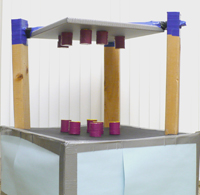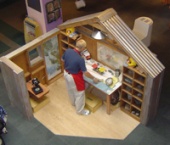How do object names affect children's expectations during play?

This study asked: Do children explore more when the evidence they see conflicts with their assumptions about the physical properties suggested by an object's name?
We showed preschoolers a set of blocks called ‘blickets.’ Children learned that these blocks were magnetic and would stick to a metal stage. We then showed them a second set of blocks that looked identical, but were not magnetic. Half the children were told these new blocks were also called ‘blickets’, and half of the children were told these new blocks were called ‘feps’. Children were then allowed to play with the new blocks on their own.
When the new blocks were called ‘blickets’ children assumed they were magnetic (like the first set of ‘blickets’), and were surprised when they did not stick to the stage. Children in this condition explored more, trying to stick multiple blocks to the stage even though the new ‘blickets’ would not stick.
However, when the new blocks were instead called ‘feps’, children were not surprised when they did not stick. Children in this condition explored less, trying fewer of the blocks on the stage. This showed researchers that, unlike with the new ‘blickets,’ children quickly assumed ‘feps’ were a new kind of toy (and wouldn't stick like the 'blickets' did).
These results suggest that children are sensitive to the relationship between the name of an object and it’s properties. The study found:
- children will spend more time engaged in exploratory play with an object whose observed characteristics contradict their assumed characteristics (children play longer when a object doesn’t do what they expect); and
- even young children are sensitive to the connection between the name of an object and its characteristics (children hold more strongly to the belief that two objects are the same when they look the same and have the same name than when two objects look the same but have different names)
If children explore more when the evidence they encounter contradicts what they ‘know’ about an object, this may be one way that children learn through play.
Try it at the Museum

Become a Geologist!
Explore the rocks and minerals in and around the Geology Field Station in the Discovery Center. Many of the rocks have hidden properties that make them stand out from the other rocks.
Has your child ever smelled a rock? Find five yellow-green rocks in the Field Station and try to figure out which one is the rock with a funny smell.
Does your child explore the rocks more, or try to smell other rocks, after finding one with a unique scent (sulfur)?
Try it at Home
Spoons
Gather some materials from around your home: a refrigerator magnet, metal spoon, plastic spoon, and wooden spoon.
Show your child how a magnet can stick to a metal spoon. Then let your child play with several metal spoons and a magnet so s/he can observe this magnetic attraction for his/herself. Next, present your child with several plastic or wooden spoons, and let them discover through play that the second group of spoons are not attracted to the magnet.
What name does your child call the second group of spoons? Do they call them ‘spoons’ even if they are not magnetic? What makes a spoon a ‘spoon’?